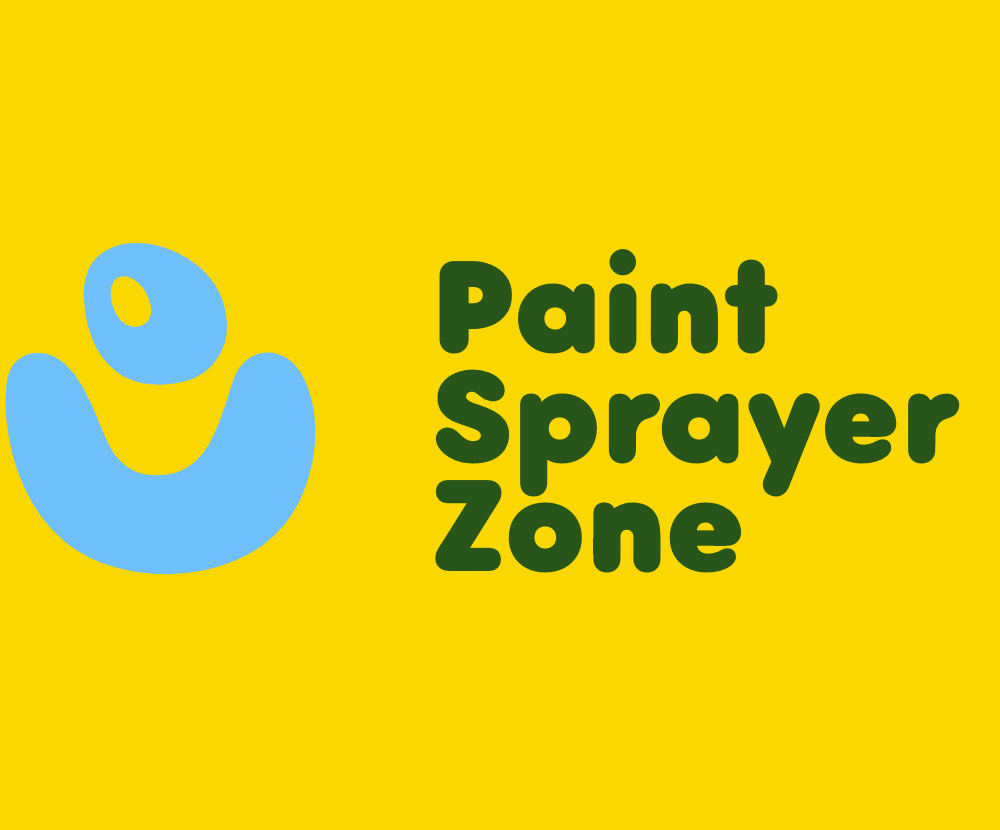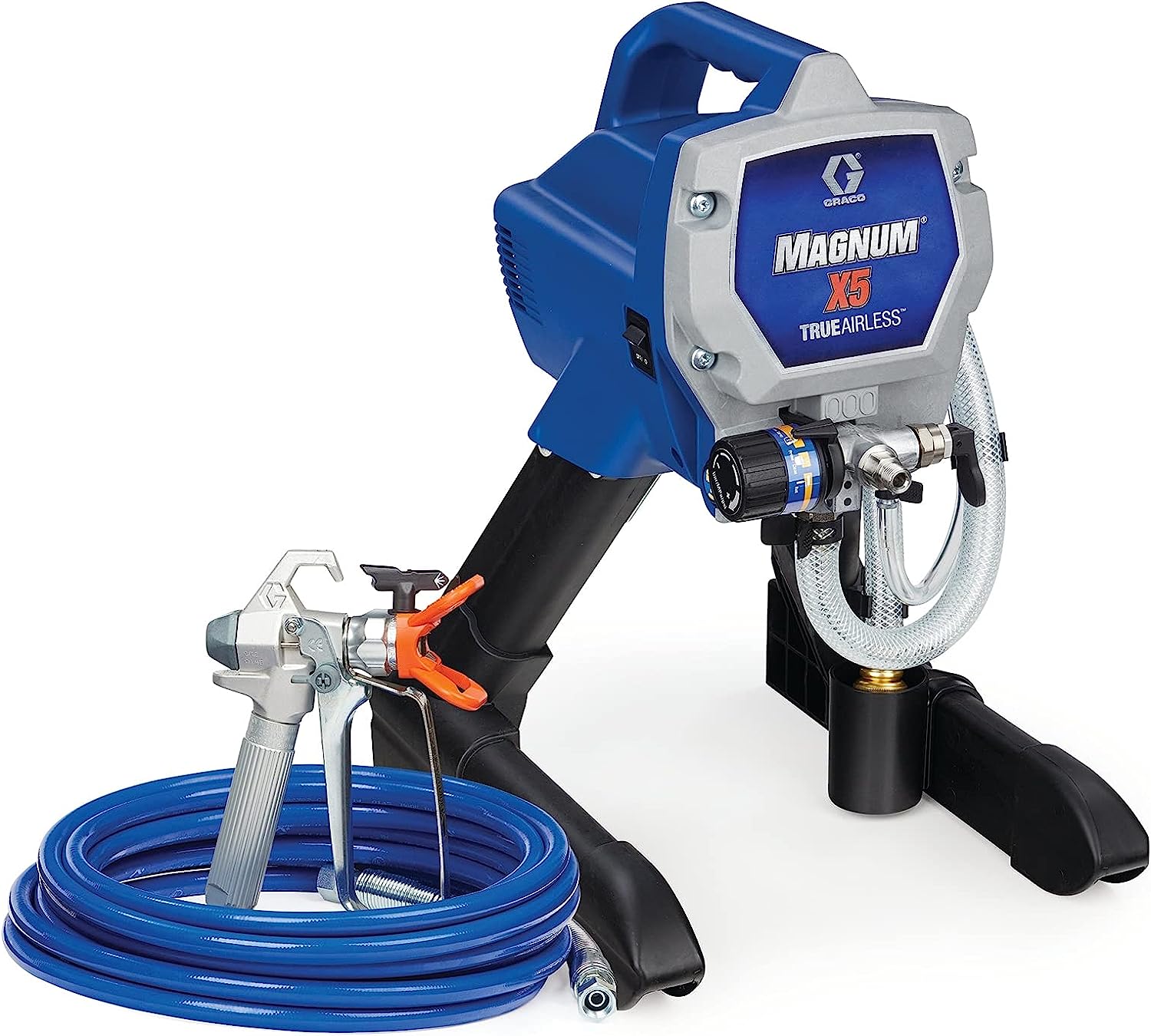How-To & Tips
Thinning Latex Paint for Airless Sprayers: Tips for Smooth, Clog-free Results
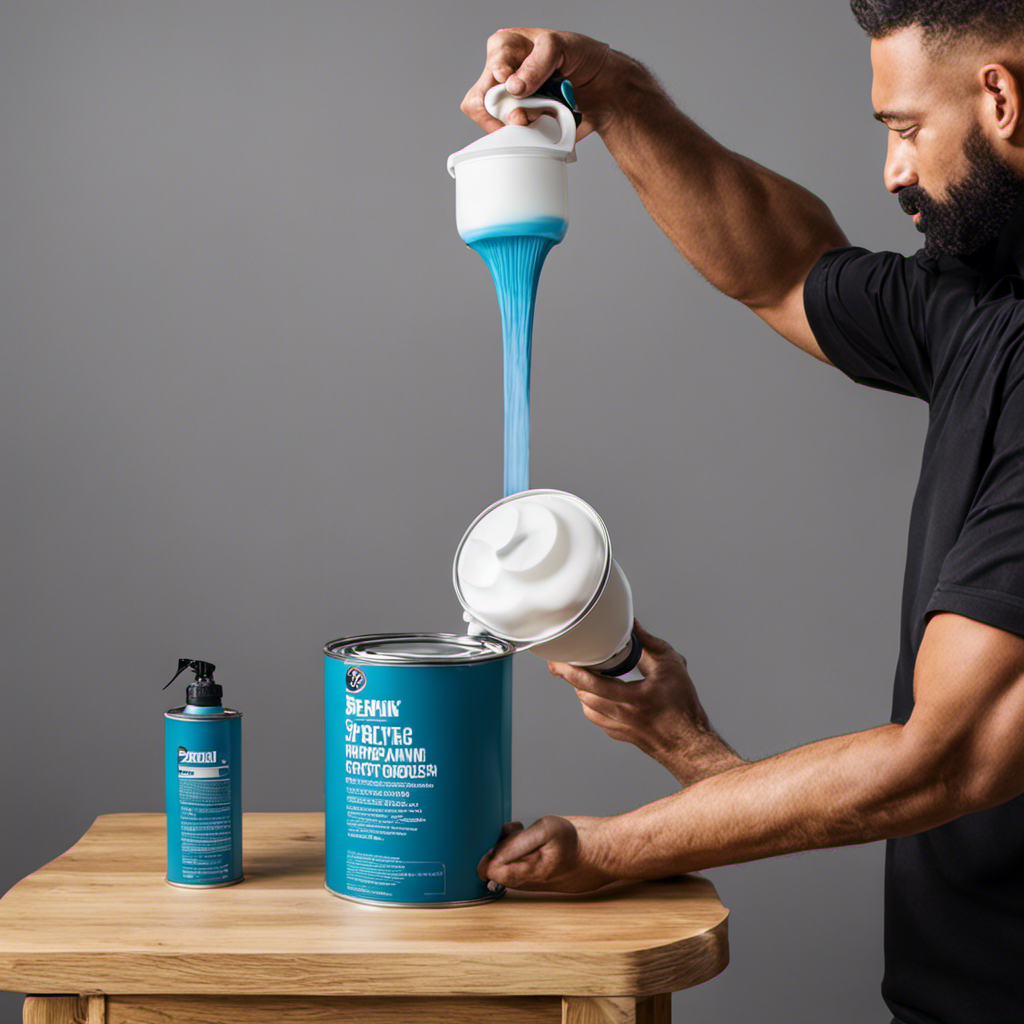
Thinning latex paint is crucial for achieving flawless, expert results with airless sprayers. It ensures a smooth and even application, preventing clogs and runs, and improves the adhesion and durability of the paint. Given that different spraying patterns require specific viscosity levels, it’s important to test and adjust before applying over the entire surface.
Following manufacturer instructions and using measuring tools is key. Regularly checking and adjusting throughout the process can troubleshoot common issues.
With these tips, painters can achieve smooth, clog-free results every time.
Key Takeaways
- Thinning latex paint is important to achieve smooth and flawless results with airless sprayers.
- Different spray patterns require different consistency, with thin paint for fine finishes and thicker paint for heavier coatings and textured surfaces.
- It is crucial to maintain the proper ratio of paint to thinners, following manufacturer’s instructions and regularly checking and adjusting the consistency throughout the painting process.
- Troubleshooting common issues such as clogged spray tips and overspray can be resolved by cleaning the sprayer, adjusting spray tip size and pressure, and applying the paint in overlapping strokes.
Understanding the Importance of Thinning Latex Paint
Thinning latex paint is important to achieve smooth and flawless results, ensure even application, prevent clogging and splattering, improve paint adhesion to surfaces, and enhance the durability and longevity of the paint job.
Improper thinning can have a negative effect on paint performance, leading to streaks, uneven coverage, and poor adhesion. To avoid these issues, it is recommended to use a professional-grade paint thinner.
Professional-grade paint thinners are specifically formulated to maintain the integrity and performance of latex paint, ensuring optimal results. They are designed to provide the perfect balance between viscosity and flow, allowing for easy application and improved paint adhesion.
Additionally, professional-grade thinners are often less prone to causing clogs and splatters, resulting in a more efficient and enjoyable painting experience.
Choosing the Right Thinning Agent for Your Airless Sprayer
To achieve optimal performance with an airless sprayer, it is crucial to select the appropriate thinning agent for the job. The best thinning agent for latex paint depends on various factors, including the desired consistency, the type of paint being used, and the surface being painted.
Water-based thinners are commonly used and readily available, providing an affordable option to reduce viscosity. Floetrol is another popular choice as it enhances smoothness and prevents clogs. Acrylic thinning agents are specialized mediums that can transform viscosity, while mineral spirits are an alternative option that requires safety precautions. Professional-grade paint thinners are also available for those seeking high-quality performance.
It is important to follow the manufacturer’s recommendations and take safety precautions when using any thinning agent to ensure smooth, clog-free results.
Adjusting Paint Consistency for Different Spray Patterns
Achieving the desired spray pattern requires adjusting the consistency of the paint for different applications. When using an airless sprayer, it is crucial to adjust the paint consistency to achieve optimal results.
Thinning the paint allows for a smoother and more even application, preventing clogs and splattering. For fine finishes and detailed work, thin the paint to a more watery consistency. On the other hand, for heavier coatings and textured surfaces, a thicker paint consistency is needed.
It is essential to test the consistency before spraying on the entire surface and make adjustments as needed. By maintaining the proper ratio of paint to thinners and regularly checking and adjusting the consistency throughout the painting process, one can achieve excellent results with an airless sprayer.
Maintaining the Proper Ratio of Paint to Thinners
Maintaining the proper ratio of paint to thinners ensures optimal performance and allows for adjustments based on desired coverage and viscosity. To achieve the best results, it is crucial to measure the paint ratios accurately. This can be done using measuring tools such as graduated containers or scales. By following the manufacturer’s instructions for recommended ratios and using the appropriate measuring tools, one can ensure consistency in the paint mixture.
To add a level of sophistication to the writing, a 2 column and 4 row table can be incorporated, showcasing different types of thinning agents and their characteristics:
| Thinning Agents | Characteristics |
|---|---|
| Water-based thinners | Reduce viscosity, readily available and affordable |
| Floetrol | Enhances smoothness, prevents clogs |
| Acrylic thinning agents | Transform viscosity, specialized mediums available |
| Mineral spirits | Alternative option, effective but requires safety precautions |
| Professional-grade paint thinners | High-quality, specifically designed for optimal results |
Step-by-Step Guide to Thinning Latex Paint for Airless Sprayers
The first step in thinning latex paint for airless sprayers is to gather all the necessary materials and equipment.
To achieve smooth, clog-free results, it is important to choose the best thinning agent and take measures to avoid paint splattering. Water-based thinners are commonly used as they reduce viscosity and are readily available and affordable. Another popular option is Floetrol, which not only enhances smoothness but also prevents clogs. Acrylic thinning agents can also be used to transform viscosity, with specialized mediums available for specific needs. However, if you prefer an alternative, mineral spirits can be effective, although safety precautions should be taken.
It is crucial to adjust the paint consistency based on the desired spray pattern, with thinner paint for fine finishes and thicker paint for heavier coatings. Regularly testing and adjusting the consistency throughout the process is essential for optimal results.
Following the manufacturer’s instructions for the proper ratio of paint to thinners, using measuring tools for accurate mixing, and avoiding excessive thinning are all important factors to consider. By following these steps and guidelines, paint splattering can be avoided, ensuring a smooth and professional finish.
Tips for Achieving a Smooth and Even Application of Paint
To ensure a flawless application, painters should focus on applying the paint evenly and smoothly. Achieving smooth finishes and preventing splattering are key goals when it comes to painting. Here are some tips to help painters achieve a smooth and even application of paint:
-
Use the right tools: Choose high-quality brushes or rollers that are suitable for the type of paint being used. This will help to ensure a smooth and even application.
-
Prepare the surface: Properly clean and prepare the surface before painting to ensure better adhesion and a smoother finish.
-
Thin the paint if necessary: Depending on the type of paint and the desired consistency, thinning the paint may be necessary to achieve a smooth application.
-
Apply multiple thin coats: Instead of applying one thick coat, it is better to apply multiple thin coats. This will help to prevent splattering and achieve a smoother finish.
-
Use proper technique: Follow proper painting techniques such as using long, even strokes and avoiding excessive pressure. This will help to achieve a smooth and even application of paint.
Troubleshooting Common Issues With Thinning Latex Paint
Clean the sprayer regularly to prevent clogs and ensure optimal performance. When using airless sprayers to apply latex paint, it is important to be aware of common issues that may arise and have troubleshooting techniques in mind. One common issue is the paint being too thick, which can lead to clogs and uneven spray patterns. To address this, thinning the latex paint is necessary. Using a 2 column and 3 row table, here are some troubleshooting techniques for thinning latex paint:
| Common Issues with Airless Sprayers | Troubleshooting Techniques for Thinning Latex Paint |
|---|---|
| Clogged spray tip | Clean the spray tip or replace if necessary |
| Uneven spray pattern | Adjust spray tip size and pressure |
| Overspray | Maintain a consistent distance from the surface |
Expert Advice for Striving for Excellence in Airless Spraying
Seeking advice and guidance from experienced painters can greatly contribute to one’s pursuit of excellence in airless spraying. These experts have honed their skills and developed techniques that can improve efficiency and overall results. By learning from their expertise, individuals can enhance their own spraying techniques and achieve better outcomes.
Some expert techniques for improving efficiency in airless spraying include:
- Proper paint thinning: Ensuring the paint is properly thinned for the specific spraying application can result in smoother and more even coats.
- Spray pattern adjustment: Understanding how to adjust the spray pattern to match the surface being painted can optimize coverage and reduce overspray.
- Sprayer maintenance: Regular cleaning and maintenance of the airless sprayer can prevent clogs and ensure consistent performance.
- Paint viscosity control: Monitoring and adjusting the paint viscosity throughout the painting process can help maintain optimal spraying consistency.
- Overlapping strokes: Applying the paint in overlapping strokes can help achieve uniform coverage and eliminate streaks or lines.
Ensuring Clog-Free Results With Proper Thinning Techniques
Thinning latex paint for airless sprayers is essential to ensure smooth and clog-free results. Proper thinning techniques play a crucial role in preventing clogs and maintaining the efficiency of the sprayer.
To achieve the right consistency, it is recommended to follow the manufacturer’s instructions regarding the paint-to-thinner ratio. Measuring tools can be used for accurate mixing. It is important to avoid excessive thinning, as it can negatively affect the performance of the paint.
Regularly checking and adjusting the consistency throughout the painting process is also recommended. By ensuring the paint is properly thinned, painters can prevent clogs in the sprayer and achieve a flawless finish.
Taking these precautions and following the right thinning techniques will help painters achieve optimal results with their airless sprayers.
Best Practices for Thinning Latex Paint for Textured Surfaces
Achieving optimal results with textured surfaces involves adjusting the paint consistency and following recommended techniques for a flawless finish. To evoke emotion in the audience, here are some best thinning agents and techniques for achieving texture:
- Water-based thinners: These readily available and affordable thinners reduce viscosity and ensure smooth application.
- Floetrol: This thinning agent enhances smoothness and prevents clogs, resulting in a professional-looking finish.
- Acrylic thinning agents: These specialized mediums transform viscosity and provide options for achieving desired texture.
- Mineral spirits: While requiring safety precautions, mineral spirits can effectively thin latex paint for textured surfaces.
- Professional-grade paint thinners: These high-quality thinners offer precise control over paint consistency, ensuring excellent results.
Final Tips and Tricks for Thinning Latex Paint With Airless Sprayers
To ensure optimal performance and efficiency, professional painters using airless sprayers should regularly inspect and maintain their equipment.
Thinning latex paint is a crucial step in achieving smooth and clog-free results. When using airless sprayers, it is important to take safety precautions when handling thinning agents.
Water-based thinners, such as Floetrol and acrylic thinning agents, are popular choices for thinning latex paint. These options not only reduce viscosity but also enhance smoothness and prevent clogs. However, if professionals prefer alternatives, mineral spirits can be used with proper safety precautions.
Maintaining the proper ratio of paint to thinners is essential for achieving the desired consistency. By following manufacturer’s instructions and regularly checking and adjusting the consistency, professional painters can ensure flawless results.
Thinning latex paint with airless sprayers requires knowledge, precision, and attention to detail to achieve the best possible outcome.
Frequently Asked Questions
Can I Use Oil-Based Thinners for Latex Paint With an Airless Sprayer?
Using oil-based thinners for latex paint in an airless sprayer can have both pros and cons.
On the positive side, oil-based thinners can help reduce the viscosity of latex paint, making it easier to spray and resulting in a smoother finish.
However, there are some drawbacks to consider. Oil-based thinners can have a strong odor and may require additional safety precautions. Additionally, they may not be compatible with all types of airless sprayers.
It’s important to carefully read the manufacturer’s instructions and test the compatibility before using oil-based thinners with a latex paint in an airless sprayer.
Are There Any Specific Safety Precautions I Should Take When Using Mineral Spirits as a Thinning Agent?
When using mineral spirits as a thinning agent for latex paint, it is important to take specific safety precautions. These include:
- Working in a well-ventilated area
- Wearing gloves and protective eyewear
- Avoiding inhalation and skin contact
Mineral spirits are flammable, so it is crucial to keep them away from open flames or sparks. Additionally, proper disposal of used mineral spirits is necessary to prevent environmental contamination.
Following these precautions ensures a safe and successful painting experience.
How Can I Tell if the Paint Consistency Is Correct Before Spraying It on the Entire Surface?
To test the paint consistency before spraying it on the entire surface, one can perform a simple viscosity test. This involves dipping a viscosity cup or a stir stick into the paint and observing how it flows off. The paint should have a smooth, even flow without any clumps or excessive dripping.
The importance of proper paint consistency cannot be understated, as it ensures an even application, prevents clogging, and promotes better adhesion to surfaces. Maintaining the correct consistency is key to achieving smooth, clog-free results when using airless sprayers.
What Should I Do if My Spray Tip Keeps Getting Clogged While Using an Airless Sprayer?
If a spray tip keeps getting clogged while using an airless sprayer, there are several solutions to consider.
First, make sure the paint is properly thinned to the manufacturer’s recommended consistency.
Secondly, check the spray tip for any debris or buildup and clean it thoroughly.
If the clogging persists, try using a larger spray tip size or reducing the pressure.
Regular maintenance and cleaning of the sprayer can also help prevent clogs.
Are There Any Special Techniques or Tips for Achieving a Fine Finish When Thinning Latex Paint for Airless Spraying?
Achieving a fine finish when thinning latex paint for airless spraying requires attention to detail and proper technique. To achieve an optimal spray pattern, it is important to thin the paint to the correct consistency and maintain a consistent distance from the surface. This helps prevent overspray and ensures even application.
Additionally, using the appropriate spray tip size and pressure can also contribute to a fine finish. By following these tips, painters can achieve smooth, clog-free results with their airless sprayers.
Conclusion
In conclusion, thinning latex paint for airless sprayers is a crucial step in achieving flawless and clog-free results. By understanding the importance of paint consistency, choosing the right thinning agent, and maintaining the proper ratio, painters can ensure smooth and even application.
Following a step-by-step guide, seeking expert advice, and practicing best practices will help painters strive for excellence in airless spraying. By employing these techniques, painters can avoid common issues and achieve professional-quality results.
So, remember to take the time to thin your paint properly for optimal performance and a flawless finish.
Franz came aboard the Paint Sprayer Zone team with a background in both journalism and home renovation. His articulate writing style, combined with a passion for DIY projects, makes him an invaluable asset. Franz has a knack for breaking down technical jargon into easy-to-understand content, ensuring that even the most novice of readers can grasp the complexities of paint sprayers.
How-To & Tips
Mastering Airless Sprayer Techniques for Perfect Ceiling Painting
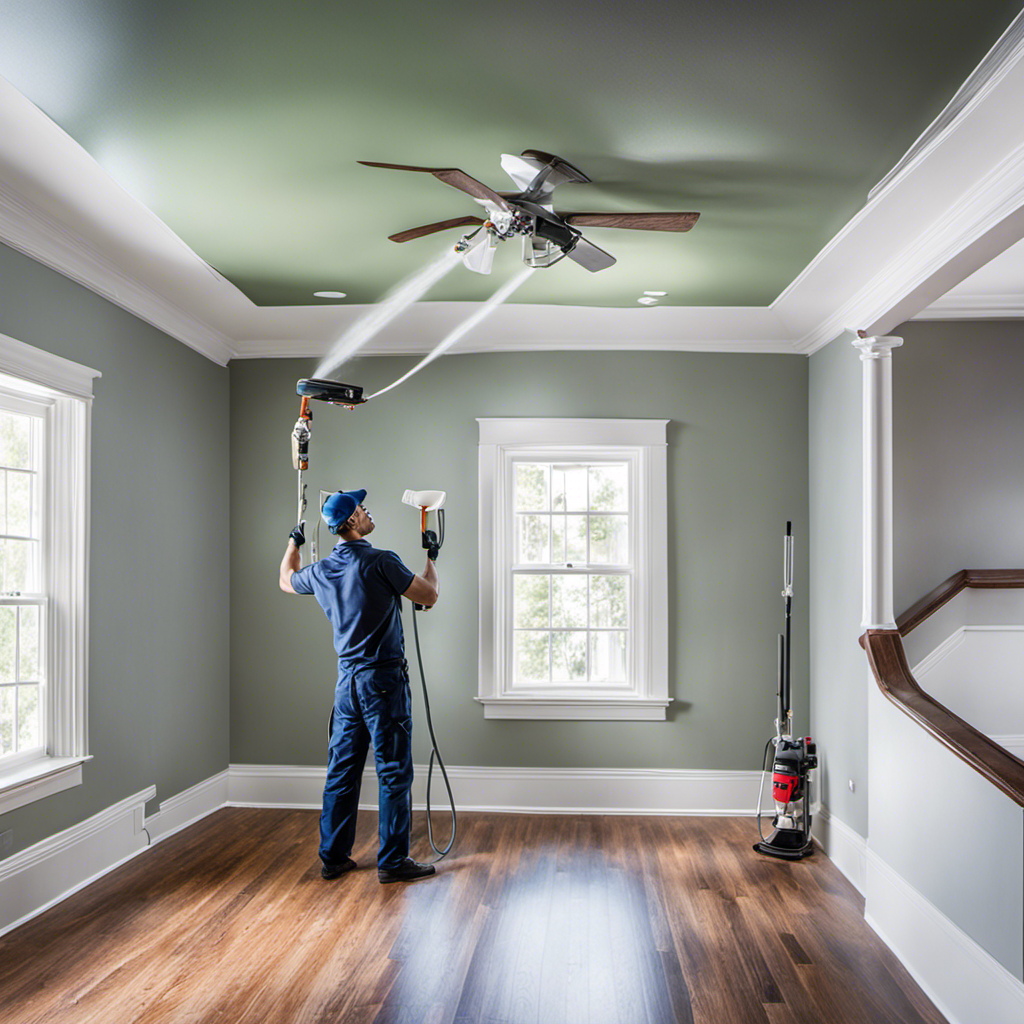
Mastering the use of airless sprayers is essential for achieving a professional finish when painting ceilings. Proper preparation and technique are key factors that make up 90% of the success of a ceiling painting project.
In this comprehensive guide, beginners and DIY enthusiasts will learn the importance of selecting the right equipment, protecting the surrounding area, and maintaining a consistent distance from the ceiling.
With tips on cleaning, overlapping passes for complete coverage, and evaluating the finished result, this article will help you achieve flawless ceilings every time.
Key Takeaways
- Proper preparation and equipment selection are crucial for achieving a professional finish when painting a ceiling with an airless sprayer.
- Maintaining a consistent distance from the ceiling and overlapping each pass slightly ensures complete coverage.
- Allow sufficient drying time before applying a second coat and touch up any areas with thin coverage or uneven paint.
- Proper cleanup and storage of the sprayer and painting equipment are essential for easy maintenance and future touch-ups.
Importance of Proper Preparation
The painter must use drop cloths or plastic sheets to protect the floor and furniture when preparing for ceiling painting. Proper preparation is crucial for achieving a flawless finish.
Preparation techniques include inspecting and repairing any cracks or holes in the ceiling, as well as cleaning the ceiling to remove dirt and dust. Common mistakes to avoid include skipping the preparation steps and not protecting the surrounding surfaces.
To ensure a flawless finish, here are some preparation tips: thoroughly clean the ceiling before painting, patch any imperfections, and consider the overall aesthetic of the room when choosing a paint color.
Selecting the Right Equipment
When selecting the right equipment, it is important to consider factors such as the size and texture of the ceiling.
Choosing the right nozzle is crucial for achieving a smooth and even spray pattern. Different nozzles offer different spray widths and fan patterns, so it’s important to select one that suits the size of the ceiling.
Troubleshooting common issues with the equipment is also essential for a successful painting job. If the sprayer is clogging or producing uneven coverage, it may be due to improper setup or maintenance. Regularly cleaning the sprayer and inspecting the filters and tips can help prevent these issues.
Protecting the Surrounding Area
To protect the surrounding area, it’s important to use drop cloths or plastic sheets and inspect for any cracks or holes in the ceiling. This will prevent paint from splattering onto furniture and other objects.
Additionally, taking the following steps can help prevent overspray and ensure a smooth painting process:
- Covering furniture with drop cloths or plastic sheets
- Securing the drop cloths or plastic sheets with tape or clamps
- Masking off any areas that should not be painted, such as light fixtures or vents
Inspecting and Repairing Ceiling Imperfections
Inspecting and repairing any cracks or holes in the ceiling is an essential step in achieving a professional finish when using an airless sprayer.
Before starting the painting process, it is important to thoroughly inspect the ceiling for any imperfections. Cracks and holes can disrupt the smoothness of the final paint job and may require additional touch-ups later on.
To repair cracks, use a joint compound or spackling paste to fill them in, making sure to smooth out the surface. For smaller holes, a lightweight spackle can be used.
Once the repairs are complete, allow sufficient drying time before proceeding with painting.
Cleaning the Ceiling Surface
Using a damp cloth or sponge, you can easily clean the ceiling surface to remove any dirt or dust particles.
To ensure a thorough cleaning, here are some effective cleaning techniques and the best cleaning solutions to use:
-
Dusting: Start by gently dusting the ceiling with a microfiber cloth or a feather duster to remove loose particles.
-
Vacuuming: If the ceiling is heavily soiled, use a vacuum cleaner with a soft brush attachment to help remove stubborn dirt and cobwebs.
-
Mild soap solution: Mix a small amount of mild dish soap with warm water. Dip the cloth or sponge into the solution and wring out excess moisture. Wipe the ceiling in gentle, circular motions to remove any stains or grime.
Remember to always test a small, inconspicuous area before cleaning the entire ceiling.
Additionally, avoid using abrasive cleaners or excessive moisture, as they can damage the ceiling surface.
Choosing the Perfect Paint Color
When selecting the ideal paint color, homeowners should consider the overall aesthetic of the room. Choosing the right paint finish and creating a color scheme are crucial for achieving the desired look.
To create a color scheme, homeowners can start by identifying the main color they want to use and then selecting complementary or contrasting colors for accents or trim. It’s important to consider factors such as natural light, room size, and existing furniture or decor when choosing paint colors.
Additionally, homeowners should consider the desired mood or atmosphere they want to create in the room. By carefully selecting paint colors and finishes, homeowners can create a cohesive and visually pleasing space.
Setting the Correct Sprayer Pressure
To achieve a smooth finish, homeowners need to ensure they set the correct sprayer pressure for their painting project. Adjusting sprayer settings is crucial in preventing overspray and achieving professional results. Here are some key points to consider:
- Consult the sprayer’s manual or manufacturer’s instructions for recommended pressure settings.
- Start with a low pressure setting and gradually increase until the desired coverage is achieved.
- Test the sprayer on a small surface to check for any inconsistencies or overspray.
- Adjust the nozzle settings to control the spray pattern and reduce overspray.
- Maintain a consistent distance from the ceiling while spraying to ensure even coverage.
- Use a sweeping motion and overlap each pass slightly for complete and uniform application.
Preparing the Airless Sprayer
When it comes to preparing the airless sprayer for painting, there are several steps to follow to ensure a smooth and efficient process.
One of the pros of using an airless sprayer is that it allows for quick and even application of paint on large surfaces like ceilings.
However, there are also some cons to consider, such as the potential for overspray and the need for proper ventilation.
Before starting, it is important to troubleshoot common issues with airless sprayers, such as clogs or uneven spray patterns.
This can be done by checking the sprayer’s filters and tips, and adjusting the pressure and nozzle settings accordingly.
Additionally, it is crucial to clean the sprayer immediately after use to prevent clogs and to properly store all painting equipment for future use.
Testing the Sprayer’s Performance
The painter checks the sprayer’s performance by testing it on a small surface to ensure it’s working correctly. This step is crucial in identifying any issues with the sprayer settings and troubleshooting them before starting the actual painting process.
Here are some important things to consider when testing the sprayer’s performance:
- Start by setting the sprayer pressure to the recommended level for the type of paint being used.
- Adjust the sprayer’s nozzle settings to achieve the desired spray pattern.
- Test the sprayer on a small surface, such as a piece of cardboard or scrap wood, to observe the spray pattern, coverage, and consistency.
- Look for any issues like uneven spray, clogs, or drips and make the necessary adjustments or repairs.
- Ensure that the sprayer is delivering the paint smoothly and evenly to achieve a professional finish.
Adjusting Spray Pattern for Even Coverage
Adjusting the sprayer’s nozzle settings allows the painter to achieve an even spray pattern for consistent coverage.
To adjust the spray pattern, the painter can start by adjusting the nozzle size. A smaller nozzle size will result in a narrower spray pattern, while a larger nozzle size will create a wider pattern. This allows for flexibility in covering different areas of the ceiling.
Additionally, troubleshooting common sprayer issues can help ensure an even spray pattern. For example, if the sprayer is producing an uneven pattern, it may be due to a clogged nozzle. Cleaning or replacing the nozzle can help resolve this issue.
Maintaining Consistent Distance From the Ceiling
Maintaining a consistent distance from the ceiling ensures an even and smooth application of paint when using an airless sprayer. This technique helps prevent overspray and ensures that the paint is evenly distributed across the surface.
To achieve this, follow these steps:
- Stand at a distance of about 12-16 inches from the ceiling.
- Hold the sprayer at a slight angle to the surface, pointing it towards the ceiling.
- Move the sprayer in a steady and controlled motion, keeping the distance consistent.
- Overlap each pass slightly to ensure complete coverage.
- Take breaks when needed to prevent fatigue and maintain accuracy.
Overlapping Each Pass for Complete Coverage
To achieve complete coverage when using an airless sprayer, it is important to overlap each pass slightly. This technique ensures that no areas are missed and helps avoid paint drips. By overlapping the spray pattern, the paint is applied evenly across the entire surface, resulting in a professional finish. Additionally, overlapping the passes helps to blend the paint and eliminate any visible lines or streaks.
When troubleshooting common sprayer issues, such as clogging or uneven spray patterns, overlapping each pass can be a helpful solution. It allows for better distribution of the paint and helps to prevent any blockages in the sprayer nozzle. By following this technique, painters can achieve consistent coverage and avoid potential problems during the painting process.
Remember to maintain a steady and consistent distance from the ceiling while overlapping each pass to ensure optimal results.
Allowing Sufficient Drying Time
Allowing enough time for the paint to dry is crucial in achieving a smooth and professional finish. To ensure a successful drying process, there are a few key steps to follow:
-
Avoiding paint drips:
-
Apply thin and even coats of paint to prevent drips from forming.
-
Use a high-quality brush or roller to minimize the risk of drips.
-
Check for any drips or excess paint and immediately smooth them out before they dry.
-
Using proper lighting:
-
Ensure that the room is well-lit to accurately evaluate the drying progress.
-
Use natural or artificial light sources to identify any missed spots or imperfections.
-
Adjust the lighting angle to reveal any areas that may need touch-ups.
Evaluating and Touching Up the Painted Ceiling
The painter evaluates the painted ceiling for any areas that may need touch-ups or additional coverage. This step is crucial to ensure a professional finish. They carefully inspect the ceiling, using proper lighting to identify any missed spots or imperfections. They consider the paint’s sheen and adjust the lighting accordingly for accurate evaluation.
If they find areas with thin coverage or uneven paint, they use touch-up techniques to correct them. This may involve using a brush or roller to apply additional paint to those areas. They make sure to blend the touch-up paint seamlessly with the rest of the ceiling to achieve a smooth and consistent appearance.
Frequently Asked Questions
Can an Airless Sprayer Be Used on Textured Ceilings?
Yes, an airless sprayer can be used on textured ceilings. However, there are some pros and cons to consider.
The main advantage is that the high pressure of the sprayer can easily cover the uneven surface of the texture. This saves time and ensures a more even finish.
On the other hand, the texture can make it harder to control overspray, which may require additional masking and protection. Regular airless sprayer maintenance is also important to prevent clogs and ensure optimal performance.
How Do You Prevent Overspray When Using an Airless Sprayer?
To prevent overspray when using an airless sprayer, it’s crucial to maintain proper maintenance and follow some key techniques.
First, ensure the sprayer is set at the correct pressure and nozzle settings for an even spray pattern.
Second, maintain a consistent distance from the ceiling while spraying and overlap each pass slightly for complete coverage.
Lastly, regularly clean the sprayer to prevent clogs and ensure optimal performance.
What Is the Best Method for Cleaning the Sprayer After Use?
The best method for cleaning the sprayer after use involves several maintenance tips.
First, it’s important to clean the sprayer immediately to prevent clogs.
Next, remove and clean any paint filters or tips.
Dispose of unused paint properly according to local regulations.
Store leftover paint in airtight containers for future touch-ups.
Finally, properly clean and store all other painting equipment.
Following these steps will ensure that the sprayer remains in good condition for future use.
How Long Should Paint Dry Before Applying a Second Coat?
The paint should be allowed to dry for a sufficient amount of time before applying a second coat. This ensures that the first coat has properly adhered to the ceiling and avoids any smudging or blending of the layers.
The exact drying time can vary depending on factors such as temperature and humidity, so it is important to refer to the paint manufacturer’s instructions for specific guidance.
Can an Airless Sprayer Be Used on Popcorn Texture Ceilings?
Using an airless sprayer on popcorn texture ceilings can be challenging due to the uneven surface. However, with proper maintenance and technique, it is possible to achieve satisfactory results.
Regular maintenance of the sprayer, such as cleaning and adjusting the pressure and nozzle settings, is crucial for optimal performance.
The benefits of using an airless sprayer, such as faster application and better coverage, still apply to popcorn texture ceilings.
It’s important to practice and test on a small area before tackling the entire ceiling.
Conclusion
In conclusion, mastering airless sprayer techniques is crucial for achieving a flawless finish when painting ceilings. By following the proper preparation steps, selecting the right equipment, and protecting the surrounding area, DIY enthusiasts can achieve professional-looking results.
For example, John, a DIY enthusiast, used the airless sprayer techniques outlined in this guide to paint his textured ceiling. He followed the recommended distance, overlapping each pass, and allowed sufficient drying time between coats. The end result was a perfectly painted ceiling that enhanced the overall look of his room.
By following these techniques, anyone can achieve a flawless finish when painting ceilings.
Franz came aboard the Paint Sprayer Zone team with a background in both journalism and home renovation. His articulate writing style, combined with a passion for DIY projects, makes him an invaluable asset. Franz has a knack for breaking down technical jargon into easy-to-understand content, ensuring that even the most novice of readers can grasp the complexities of paint sprayers.
How-To & Tips
Mastering Airless Sprayer Techniques for Flawless Paint Finish
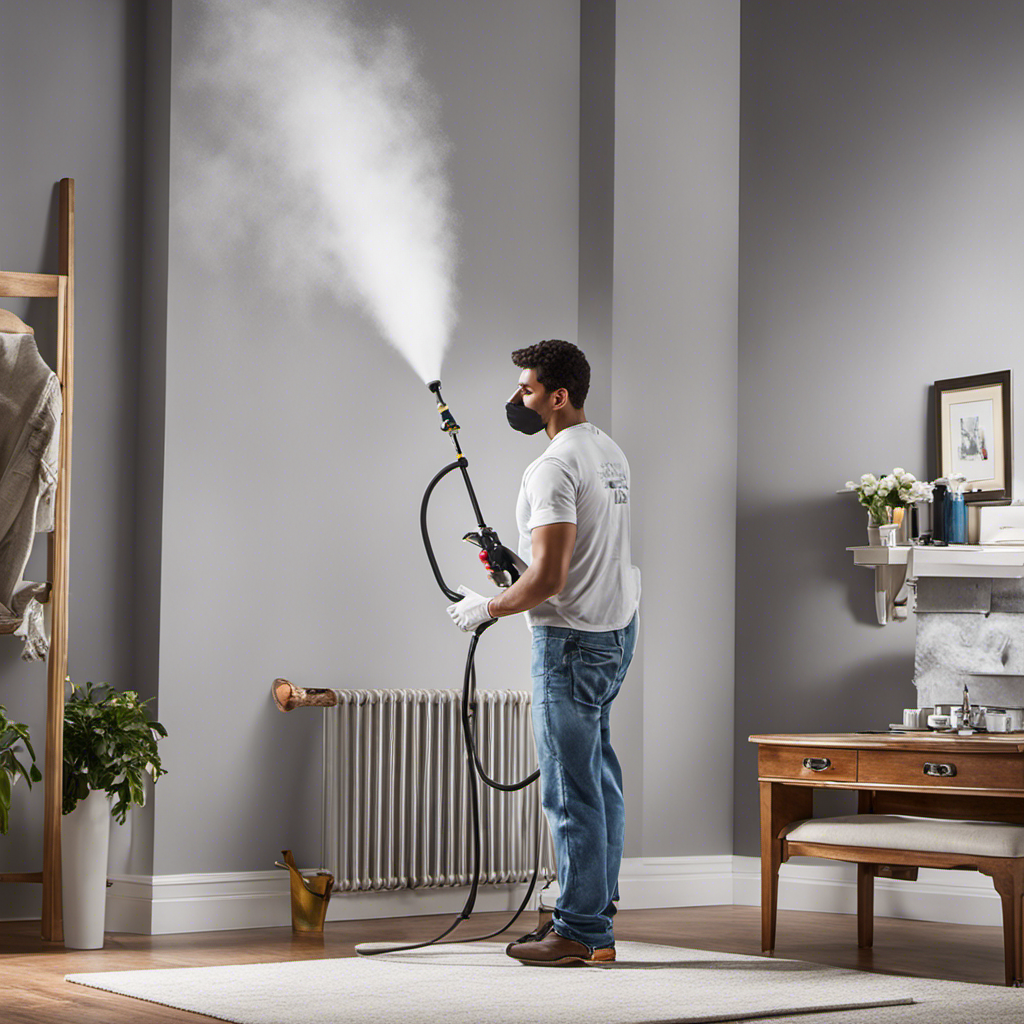
Are you in search of the perfect paint finish? You’ve come to the right place. Mastering the use of an airless sprayer is essential for achieving professional-quality results.
In this article, we will delve into the world of airless sprayers and explore the proper techniques that will leave your surfaces streak-free and flawless.
From understanding the sprayer system to choosing the right paint and adjusting the spray pressure, we will cover all the essential steps to help you achieve a smooth and impeccable finish every time.
So, let’s dive in and master those airless sprayer techniques!
Key Takeaways
- Choosing the right tip size ensures proper atomization and even application of paint.
- Maintaining a consistent distance from the surface and moving in a steady, overlapping motion helps prevent streaks.
- Proper maintenance and correct usage of the sprayer system are crucial to avoid paint streaks.
- Thinning paint allows for better atomization and smoother application.
Understanding the Airless Sprayer System and Proper Technique
The airless sprayer system uses high pressure to force paint through a small opening, creating a fine mist that ensures a smooth and even application of paint. Proper sprayer maintenance and troubleshooting techniques are essential for achieving optimal results.
Regularly cleaning the sprayer and inspecting and replacing worn parts can prevent issues that may result in paint streaks. Lubricating the sprayer properly ensures smooth operation. Troubleshooting techniques, such as checking for clogs or blockages in the sprayer and adjusting the spray pattern and pressure, help address any problems that arise during the painting process.
Proper Surface Preparation for a Flawless Finish
Inspecting the surface for imperfections and rough spots before painting is an essential step in achieving a professional-looking result. To ensure a flawless finish, one must use proper sanding techniques to smooth out any bumps or uneven areas.
Choosing sandpaper with the appropriate grit is crucial for achieving the desired level of smoothness. After sanding, it is important to thoroughly clean the surface to remove dust and debris.
Once the surface is clean, applying a primer is the next step in the priming process. The primer seals the surface and provides a smooth base for paint adhesion.
Proper surface preparation, including sanding and priming, minimizes the chances of paint streaks and ensures a professional-looking finish. Taking the time to properly prepare the surface will result in a flawless paint application.
Choosing the Right Paint and Thinning Ratio
To achieve a smooth and even application of paint, one must consider the appropriate paint type and thinning ratio. The importance of proper paint storage and handling cannot be overstated.
Storing paint in a cool, dry place and sealing the containers tightly help maintain its quality. Before starting a project, it is crucial to mix the paint thoroughly to ensure consistent color and texture.
Achieving optimal paint coverage also relies on the right spraying technique. Maintaining a consistent distance from the surface and moving in a steady, overlapping motion ensures an even coat. Adjusting the spray pressure and using the correct tip size further contribute to a flawless finish.
Adjusting the Spray Pressure for Consistent Results
Achieving consistent results with an airless sprayer relies on adjusting the spray pressure to find the optimal setting for the desired spray pattern. Here are some spray pressure adjustment tips and troubleshooting techniques to ensure a flawless paint finish:
- Start with a low pressure setting and gradually increase it until the desired spray pattern is achieved.
- Use a pressure gauge to accurately measure and adjust the spray pressure.
- Check the manufacturer’s recommendations for the optimal pressure range for the specific paint.
By testing the spray pattern on a scrap surface before starting the project and making proper spray pressure adjustments, you can eliminate paint streaks and achieve professional-looking results.
Troubleshooting common spray pressure issues involves checking for clogs or blockages in the sprayer and adjusting the pressure as needed. Regularly cleaning and maintaining the sprayer, as well as using filters and strainers, will help prevent issues and ensure a smooth spraying experience.
Preventing Clogs and Blockages for Smooth Spraying Experience
Regularly cleaning and maintaining the sprayer, as well as using filters and strainers, helps prevent clogs and blockages, ensuring a smooth spraying experience. Cleaning techniques and troubleshooting tips are essential for maintaining an airless sprayer system. By incorporating these practices into your routine, you can minimize the risk of clogs and blockages that can disrupt the paint flow and lead to uneven application. Additionally, using filters and strainers helps catch debris or particles in the paint, preventing them from entering the sprayer and causing potential issues. To provide a visual representation of the importance of cleaning and maintaining the sprayer, here is a table outlining some effective cleaning techniques and troubleshooting tips:
| Cleaning Techniques | Troubleshooting Tips |
|---|---|
| Regularly clean the sprayer after each use | Check for clogs or blockages in the sprayer |
| Thoroughly clean all parts of the sprayer, including the nozzle and hose | Adjust the spray pattern and pressure as needed |
| Inspect and replace worn or damaged parts | Properly lubricate the sprayer for smooth operation |
| Use filters and strainers to catch debris or particles in the paint | Address any problems that arise during the painting process |
Frequently Asked Questions
What Are Some Common Mistakes to Avoid When Using an Airless Sprayer?
When using an airless sprayer, there are some common mistakes to avoid in order to achieve even coverage.
One mistake is not properly maintaining the sprayer, which can lead to clogs and streaks.
Another mistake is not choosing the right tip size, resulting in uneven application of paint.
Additionally, not adjusting the spray pressure correctly can cause paint streaks.
How Can I Achieve a Smooth Finish on Textured Surfaces With an Airless Sprayer?
Achieving even coverage on textured surfaces with an airless sprayer requires careful consideration of nozzle selection. Choosing the right nozzle size ensures proper atomization and distribution of paint.
A larger nozzle size may be necessary for textured surfaces to allow the paint to flow smoothly and cover the surface evenly.
Additionally, adjusting the spray pressure and maintaining a consistent distance from the surface while moving in a steady, overlapping motion will help achieve a flawless finish on textured surfaces.
What Are Some Tips for Avoiding Overspray When Using an Airless Sprayer?
To avoid overspray when using an airless sprayer, proper cleaning techniques and avoiding clogging issues are essential.
First, regularly clean the sprayer after each use to remove any residual paint or debris that could cause clogs.
Additionally, use filters and strainers to catch any particles in the paint that could lead to clogging.
Can I Use an Airless Sprayer to Apply Different Types of Paint, Such as Latex and Oil-Based?
Using an airless sprayer for intricate paint designs has its pros and cons when it comes to different paint types.
While airless sprayers are versatile and can handle both latex and oil-based paints, it’s important to consider a few factors.
Latex paints are generally easier to spray and clean up, but they may require more thinning for optimal atomization.
Oil-based paints can be more challenging due to their higher viscosity, but they provide a smoother finish.
Proper thinning and adjusting the spray pressure are crucial for achieving flawless results with different paint types.
How Do I Troubleshoot and Fix Uneven Spray Patterns With an Airless Sprayer?
To troubleshoot and fix uneven spray patterns with an airless sprayer, there are a few techniques to keep in mind.
First, check the spray tip for any clogs or blockages and clean it thoroughly.
Next, adjust the spray pressure to ensure a consistent flow of paint.
Additionally, make sure the sprayer is held at a consistent distance from the surface and moved in a steady, overlapping motion.
These troubleshooting techniques will help you achieve a flawless paint finish.
Conclusion
In conclusion, mastering airless sprayer techniques is essential for achieving a flawless paint finish. By using the proper sprayer system and technique, one can avoid those dreaded paint streaks.
It’s ironic how such a seemingly simple task can require attention to detail and precise execution. But fear not, with the right tips, consistent distance, and steady motion, anyone can become a pro at this art.
Just remember to properly maintain your sprayer, prepare your surface, choose the right paint, adjust the spray pressure, and prevent clogs.
Happy painting!
Franz came aboard the Paint Sprayer Zone team with a background in both journalism and home renovation. His articulate writing style, combined with a passion for DIY projects, makes him an invaluable asset. Franz has a knack for breaking down technical jargon into easy-to-understand content, ensuring that even the most novice of readers can grasp the complexities of paint sprayers.
How-To & Tips
The Importance of Lubrication for Airless Paint Sprayers
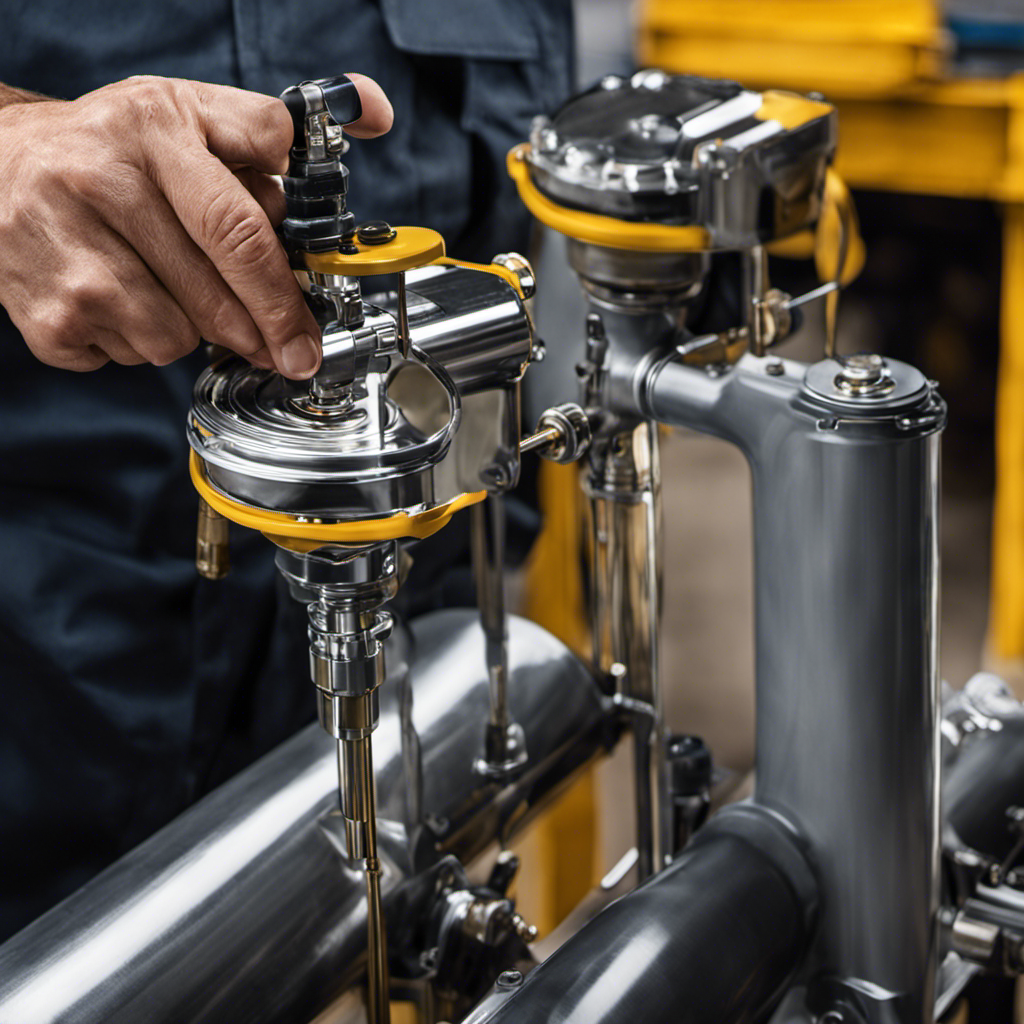
It is crucial to keep airless paint sprayers properly lubricated to maintain their efficiency and enhance their longevity. Regular lubrication can prevent costly repairs and increase the service life of the equipment. It allows for smooth and effective operation by preventing clogs and reducing wear. By reducing friction and wear on moving parts, lubrication improves overall performance.
Different types of lubricants, such as silicone, mineral oil, and synthetic lubricants, can be used. Following manufacturer instructions for regular maintenance, including cleaning the sprayer before lubrication and applying the appropriate amount, is essential for optimal performance.
Troubleshooting tips and maintenance advice are also provided in this article.
Key Takeaways
- Using the right lubricant is crucial for maintaining an airless paint sprayer.
- Regular lubrication helps prevent costly repairs and extends the lifespan of the equipment.
- Proper lubrication is important for smooth and efficient operation, preventing clogs or damage.
- Lubricating reduces friction and wear on moving parts, extending the lifespan and enhancing efficiency.
The Benefits of Regular Lubrication
Regular lubrication helps prevent costly repairs and extends the lifespan of the equipment. It also ensures smooth and efficient operation of airless paint sprayers. The importance of regular lubrication cannot be overstated. Lubrication plays a crucial role in enhancing the efficiency and lifespan of the equipment. By reducing friction and wear on moving parts, lubrication helps to maintain consistent performance and prevent clogs or damage. It also minimizes the risk of breakdowns and costly repairs.
Proper lubrication ensures that the airless paint sprayer operates smoothly and efficiently, resulting in a high-quality paint finish. Regular maintenance and lubrication are essential for optimal working condition and to maximize the longevity and efficiency of the equipment.
Types of Lubricants for Airless Paint Sprayers
Silicone lubricants provide excellent lubrication, high heat resistance, and water repellency for airless paint sprayers. When it comes to choosing the best lubricant for your airless paint sprayer, silicone lubricants are the top choice. They offer superior lubrication properties that ensure smooth and efficient operation of the equipment.
Additionally, silicone lubricants have high heat resistance, preventing the lubricant from breaking down under the high temperatures generated by the sprayer. They also provide water repellency, protecting the equipment from moisture damage.
As for the lubrication frequency, it is recommended to lubricate your airless paint sprayer according to the manufacturer’s instructions. Regular lubrication is essential for maintaining the longevity and optimal performance of your equipment.
Steps to Properly Lubricate Your Equipment
To properly lubricate the equipment, the user should first clean the sprayer to remove any debris or paint residue. This ensures that the lubricant can effectively coat the necessary parts and provide optimal performance. After cleaning, the following steps should be followed for proper lubrication techniques:
-
Refer to the manufacturer’s instructions: Different airless paint sprayers may have specific lubrication requirements, so it’s important to follow the guidelines provided.
-
Use the recommended lubricant: Using the wrong type of lubricant can lead to inadequate lubrication or even damage to the equipment. It’s essential to use the lubricant recommended by the manufacturer for optimal results.
-
Apply the lubricant to the appropriate parts: Focus on lubricating the moving components of the sprayer, such as the piston rod, packings, and seals. Apply the lubricant evenly and ensure proper coverage.
-
Avoid over-lubrication: Applying too much lubricant can cause excess buildup, leading to clogs and decreased performance. Use the correct amount of lubricant as specified by the manufacturer.
Troubleshooting Common Lubrication Issues
Properly maintaining the equipment includes troubleshooting common lubrication issues to ensure optimal performance.
Airless paint sprayers may encounter a few common lubrication problems that can affect their efficiency and lifespan.
One common issue is the presence of debris or paint residue in the lubrication system, leading to clogs and reduced lubrication. This can be resolved by thoroughly cleaning the sprayer before applying lubricant.
Another problem is the use of incorrect lubricant or using too much of it, which can cause build-up and interfere with the sprayer’s operation. It is important to use the recommended lubricant and apply the correct amount.
Additionally, improper storage or lack of regular maintenance can also result in lubrication issues.
Maintenance Tips for Extending the Lifespan of Your Sprayer
Regular maintenance and proper storage are key factors in extending the lifespan of an airless paint sprayer. To ensure the longevity of your equipment, follow these storage techniques and cleaning methods:
-
Store in a clean and dry area: Keep your paint sprayer in a clean and dry environment to prevent dust and moisture buildup, which can lead to clogs and damage.
-
Clean after each use: Thoroughly clean the sprayer after each use to remove any paint residue or debris that may affect its performance. Use appropriate cleaning solutions and follow the manufacturer’s instructions.
-
Protect sensitive parts: Cover the spray tip and other sensitive parts with protective caps when not in use to prevent damage and maintain their effectiveness.
-
Use quality storage containers: Store your paint sprayer in a sturdy and well-sealed container to protect it from accidental damage and ensure its safety during transportation or storage.
Commonly Asked Questions About Lubrication for Airless Paint Sprayers
Using the correct type of lubricant is crucial for maintaining the optimal performance and longevity of an airless paint sprayer. The frequency of lubrication and the choice of lubricant are important factors to consider. To help you make an informed decision, here are some commonly asked questions about lubrication for airless paint sprayers:
| Question | Answer |
|---|---|
| Can I use any type of lubricant on my airless paint sprayer? | It is recommended to use lubricants specifically designed for airless paint sprayers. |
| How often should I lubricate my airless paint sprayer? | The lubrication frequency depends on the manufacturer’s guidelines, but typically, it is recommended to lubricate the sprayer after every 50 hours of use. |
| Can I over-lubricate my airless paint sprayer? | Yes, over-lubrication can lead to clogs and other issues. Follow the manufacturer’s instructions for the correct amount of lubricant to use. |
| What are the signs that my airless paint sprayer needs lubrication? | If you notice increased friction, unusual noises, or decreased performance, it may be time to lubricate your sprayer. |
| Are there any specific maintenance tips I should follow to keep my airless paint sprayer in good condition? | In addition to regular lubrication, proper storage, cleaning, and inspection of parts are essential for maintaining your airless paint sprayer’s longevity. |
Expert Tips for Maintaining Optimal Performance
To ensure optimal performance, experts recommend following the manufacturer’s guidelines for lubrication frequency and choice of lubricant for maintenance of an airless paint sprayer. Proper maintenance is essential for maintaining the longevity and efficiency of the equipment.
Here are some expert tips to help you maintain optimal performance:
-
Determine the maintenance frequency: Consult the manufacturer’s guidelines to determine how often your airless paint sprayer needs to be lubricated. Regular lubrication is essential for smooth and efficient operation.
-
Choose the right lubricant: Selecting the appropriate lubricant is crucial for preventing wear and tear on moving parts. Consider factors such as heat resistance, water repellency, and rust prevention when choosing the lubricant.
-
Clean before lubrication: Before applying the lubricant, ensure that the sprayer is clean and free from any debris or paint residue. This will help prevent clogs and ensure proper lubrication.
-
Follow the instructions: Apply the lubricant to the recommended parts as per the manufacturer’s instructions. Use the correct amount of lubricant to ensure proper coverage and performance.
Frequently Asked Questions
Can I Use WD-40 or Other General-Purpose Lubricants on My Airless Paint Sprayer?
Using WD-40 or other general-purpose lubricants on an airless paint sprayer is not recommended. Using alternative lubricants can have adverse effects on the equipment. It may not provide the necessary lubrication needed for smooth operation and can potentially cause damage to the sprayer.
It is important to use the lubricants recommended by the manufacturer to ensure optimal performance and to maintain the longevity of the equipment.
Is It Necessary to Use a Specific Brand of Lubricant Recommended by the Manufacturer?
Using alternative lubricants for airless paint sprayers is not recommended. The potential consequences of using the wrong lubricant on an airless paint sprayer can be detrimental to its performance and lifespan. Manufacturers usually provide specific lubricant recommendations for their equipment, and it is necessary to follow these guidelines.
Using a lubricant that is not recommended may result in decreased efficiency, increased wear and tear, and potential damage to the paint sprayer. It is best to stick to the lubricants recommended by the manufacturer to ensure optimal operation and longevity.
How Do I Know if I Have Applied Enough Lubricant to My Airless Paint Sprayer?
To ensure the lifespan of an airless paint sprayer, it’s important to know if enough lubricant has been applied. Common signs of insufficient lubrication include increased friction, sticking parts, and decreased performance.
To maintain the sprayer’s lifespan, it’s crucial to evenly apply the recommended amount of lubricant to the appropriate parts. This will prevent wear and tear, ensure smooth operation, and extend the equipment’s longevity.
Proper lubrication is essential for optimal performance and to avoid costly repairs.
Can I Use a Lubricant That Is Not Recommended for High Heat Resistance on My Sprayer?
Using non-recommended lubricants on airless paint sprayers can pose potential risks and consequences. It is important to use heat-resistant lubricants specifically designed for airless paint sprayers. These lubricants provide the necessary protection against high temperatures and ensure smooth operation without compromising the equipment’s performance.
Using a lubricant that is not recommended for high heat resistance may lead to overheating, damage to the equipment, and decreased efficiency. It is crucial to follow the manufacturer’s guidelines and use the appropriate lubricant for optimal results.
Are There Any Alternative Methods of Lubrication for Airless Paint Sprayers?
Alternative lubrication methods for airless paint sprayers provide additional options for maintaining optimal performance. While using the recommended lubricants is crucial, some users may prefer to explore alternatives.
However, it is important to note that alternative methods may not offer the same level of effectiveness and benefits as the recommended lubricants.
Regular lubrication, using the appropriate lubricant, helps prevent costly repairs, extends equipment lifespan, and ensures smooth operation.
Conclusion
In conclusion, regular lubrication is crucial for the efficient and long-lasting performance of airless paint sprayers. By reducing friction and wear on moving parts, proper lubrication enhances the sprayer’s efficiency and prevents costly repairs.
Choosing the right lubricant, following manufacturer’s instructions, and performing regular maintenance are key steps in ensuring optimal working condition. Remember, ‘a well-oiled machine’ is not just an idiom but a literal expression of the importance of lubrication in maintaining the sprayer’s functionality.
So, keep your sprayer well-lubricated to keep it running smoothly and extend its lifespan.
Franz came aboard the Paint Sprayer Zone team with a background in both journalism and home renovation. His articulate writing style, combined with a passion for DIY projects, makes him an invaluable asset. Franz has a knack for breaking down technical jargon into easy-to-understand content, ensuring that even the most novice of readers can grasp the complexities of paint sprayers.
-
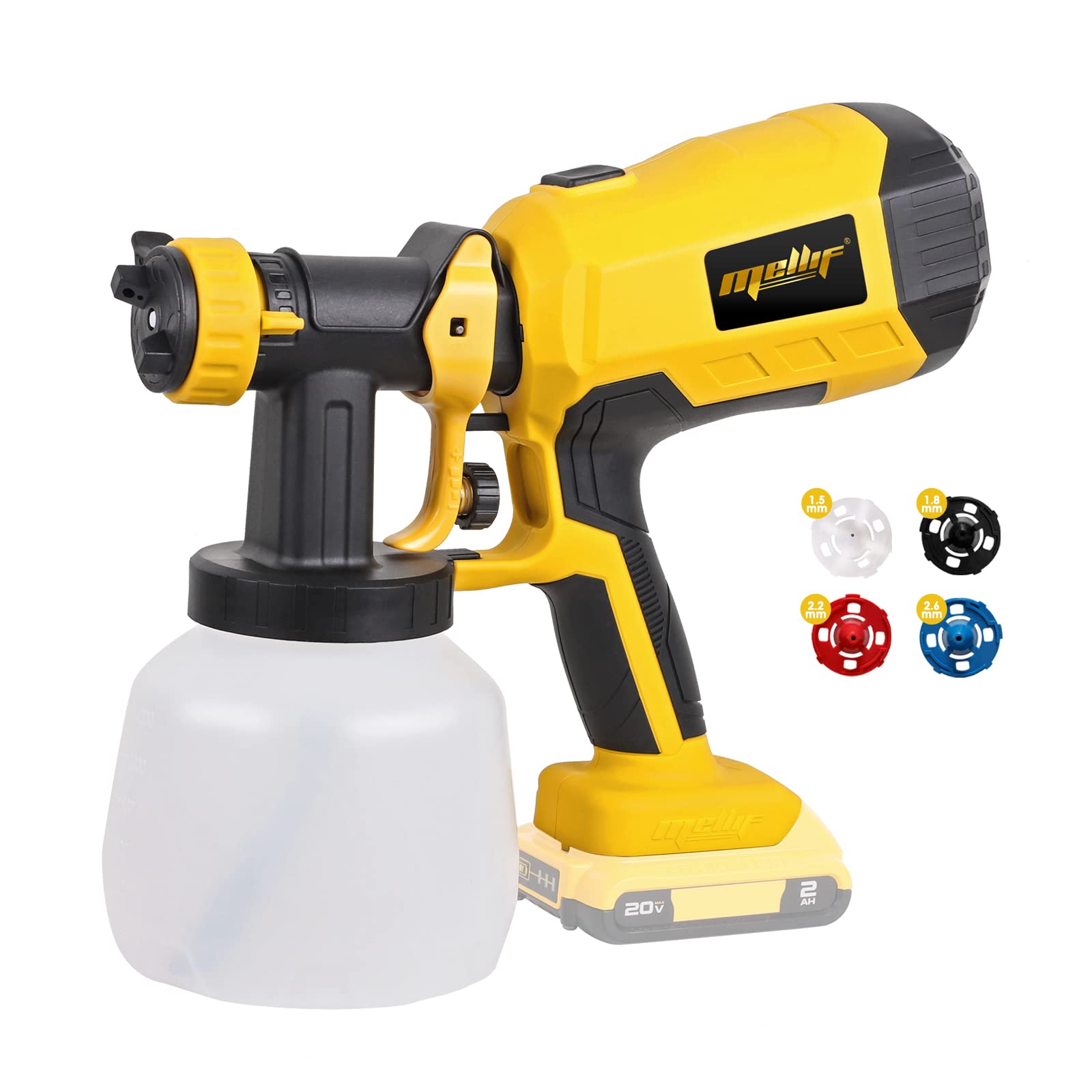
 Paint Sprayer Reviews & Buying Guides1 day ago
Paint Sprayer Reviews & Buying Guides1 day agoDEWALT 20V Cordless Paint Sprayer Review (2023)
-
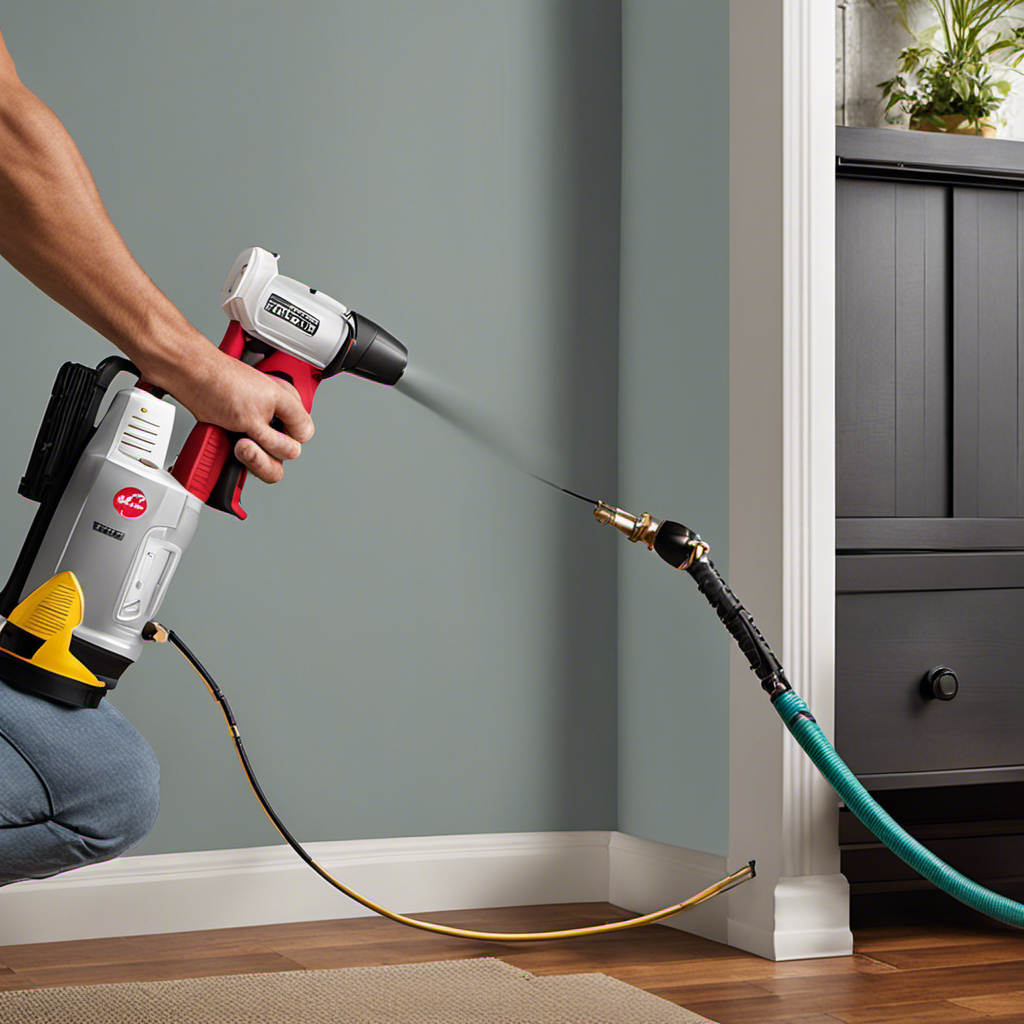
 Paint Sprayer Reviews & Buying Guides3 months ago
Paint Sprayer Reviews & Buying Guides3 months agoCalculating Paint Needs for Airless Sprayer: Coverage, Surfaces, and Tips (2023)
-
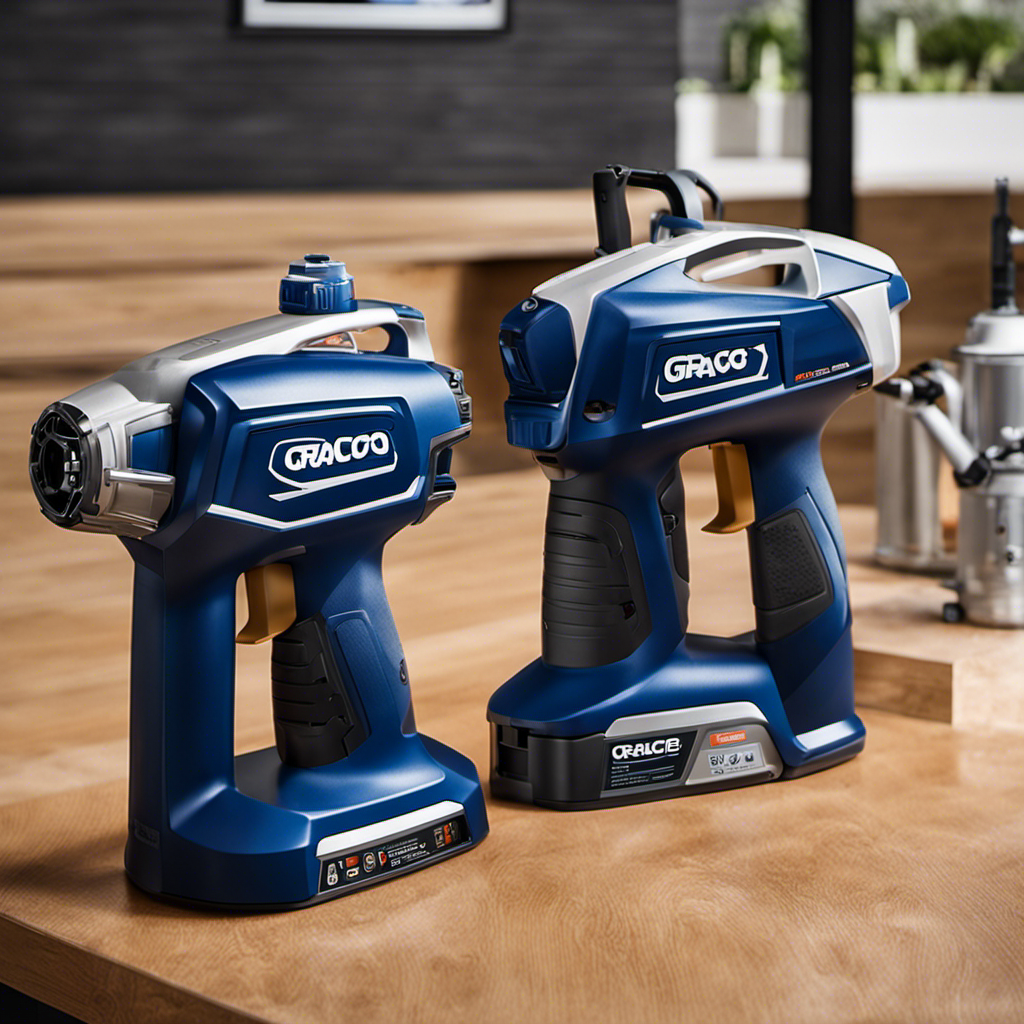
 Paint Sprayer Reviews & Buying Guides3 months ago
Paint Sprayer Reviews & Buying Guides3 months agoGraco Truecoat 360: DSP Vs VSP – a Comparison of Power and Portability (2023)
-

 How-To & Tips3 months ago
How-To & Tips3 months agoMastering the Avanti Airless Paint Sprayer: Tips and Techniques
-
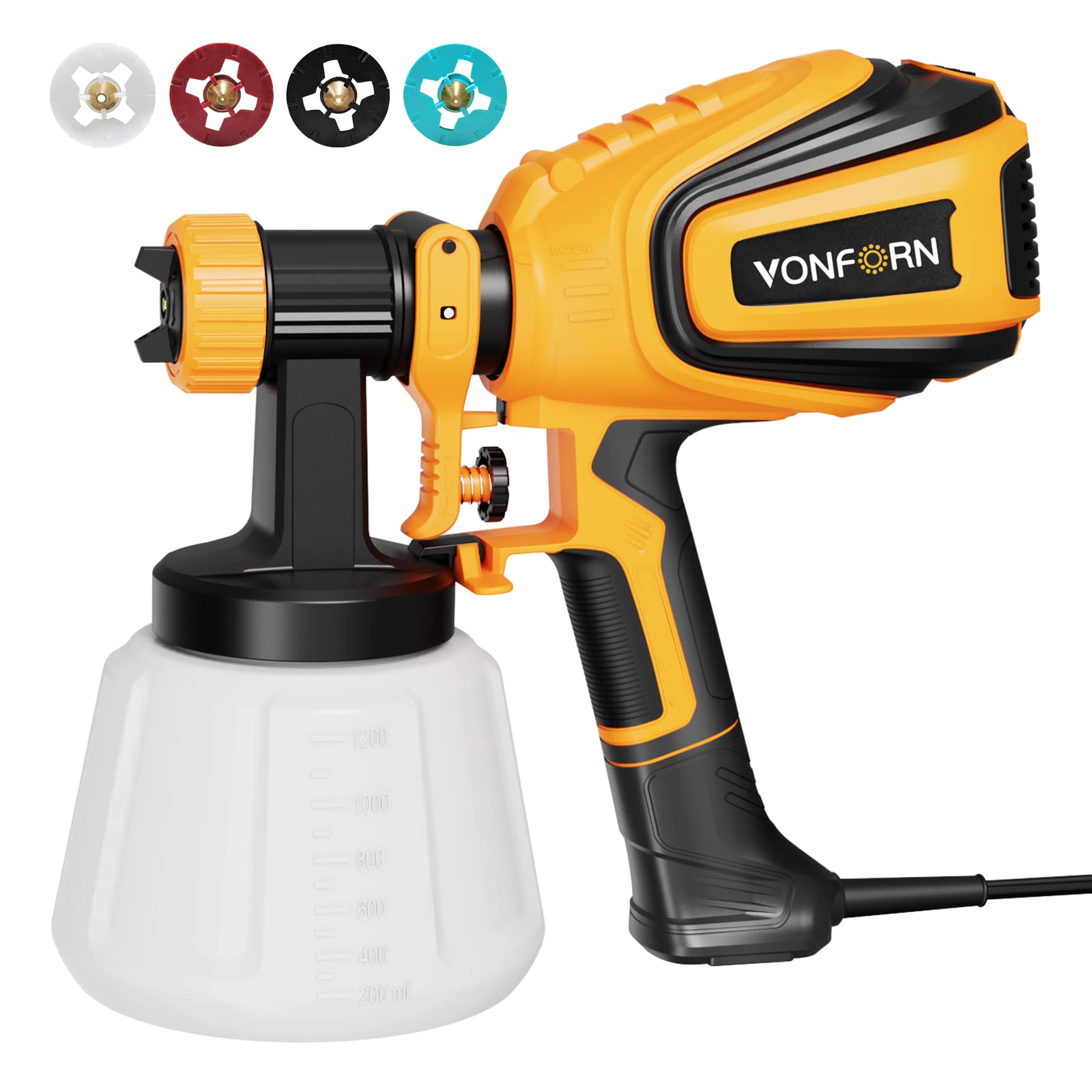
 Paint Sprayer Reviews & Buying Guides2 days ago
Paint Sprayer Reviews & Buying Guides2 days agoVONFORN Paint Sprayer Review: High Performance HVLP Spray Gun (2023)
-

 Paint Sprayer Reviews & Buying Guides1 week ago
Paint Sprayer Reviews & Buying Guides1 week agoSpray Painting Hazards: Safety Measures and Compliance (2023)
-
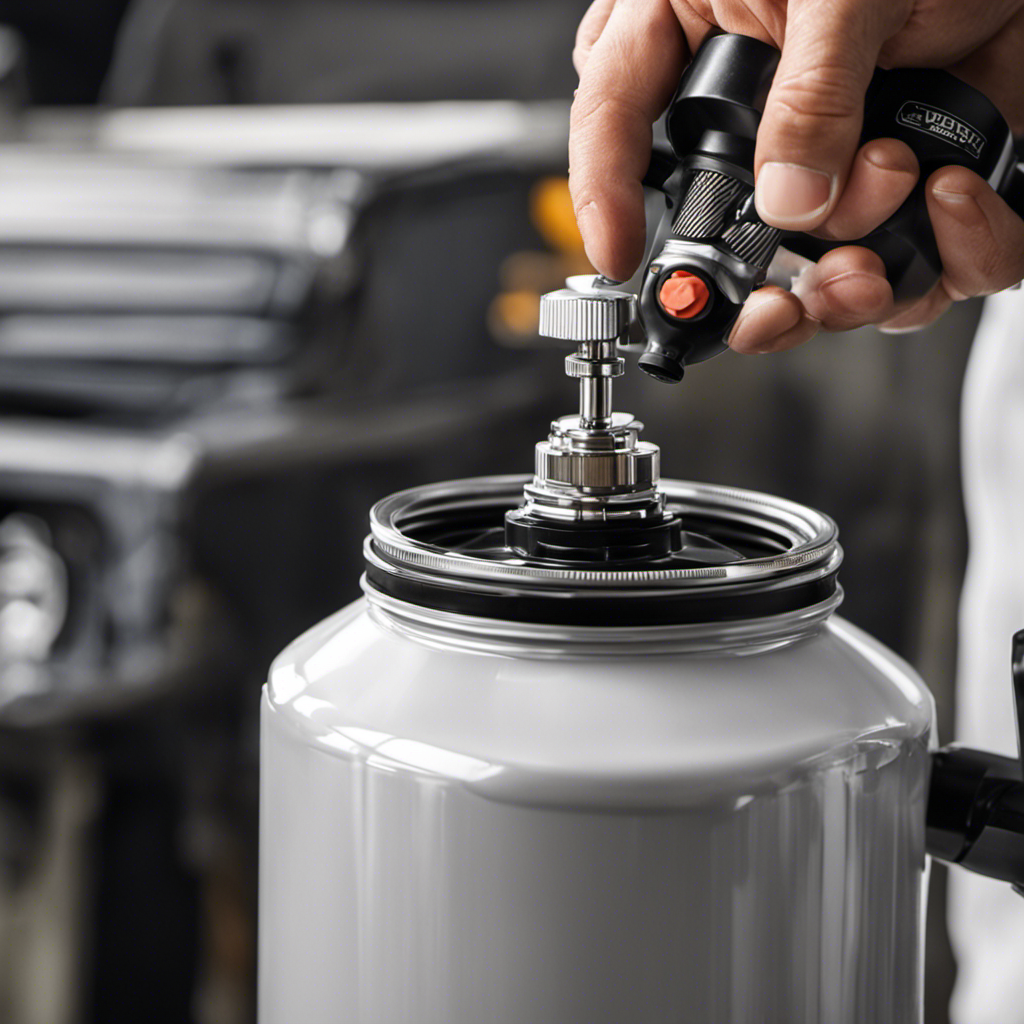
 Paint Sprayers FAQs3 days ago
Paint Sprayers FAQs3 days agoHow to Adjust Pressure on Airless Paint Sprayer
-

 Paint Sprayer Maintenance and Troubleshooting3 months ago
Paint Sprayer Maintenance and Troubleshooting3 months agoWhy Using the Right Oil Matters for Your Airless Paint Sprayer
